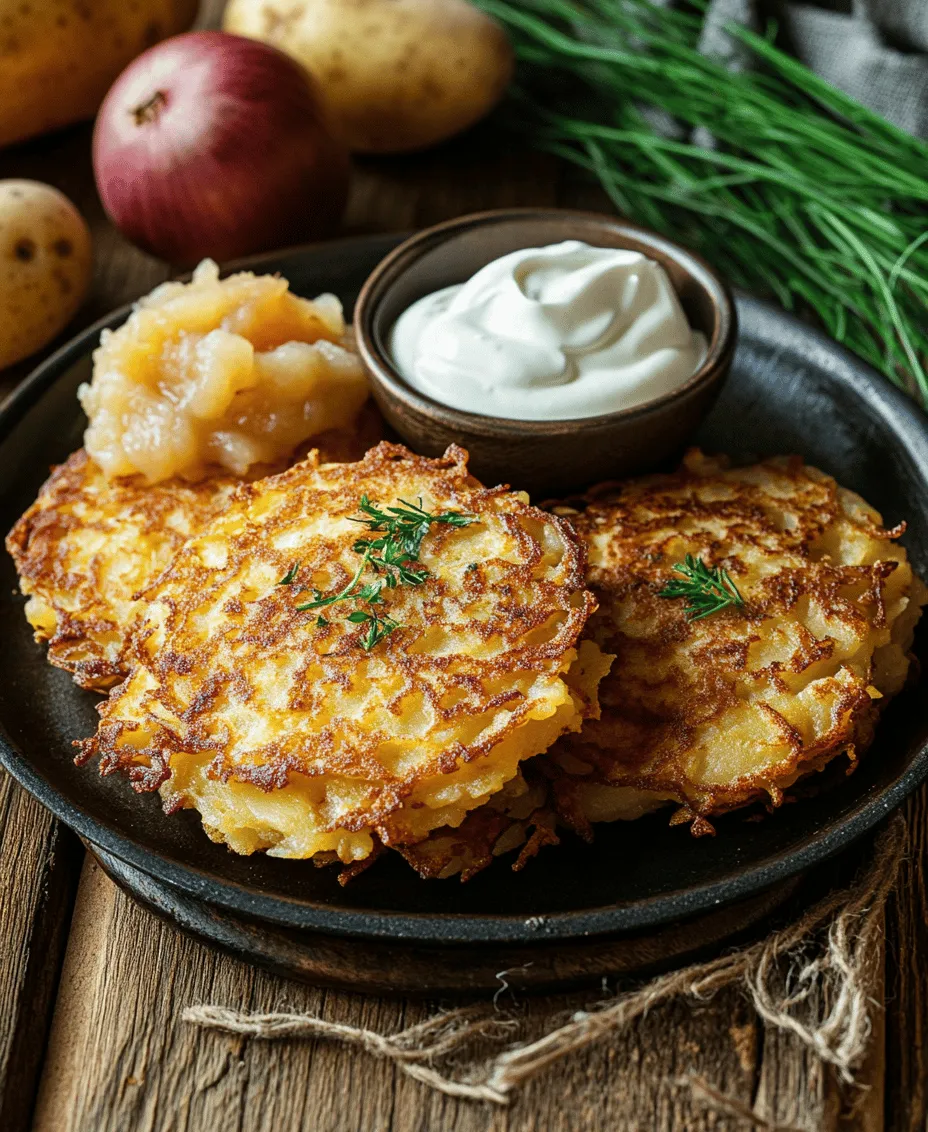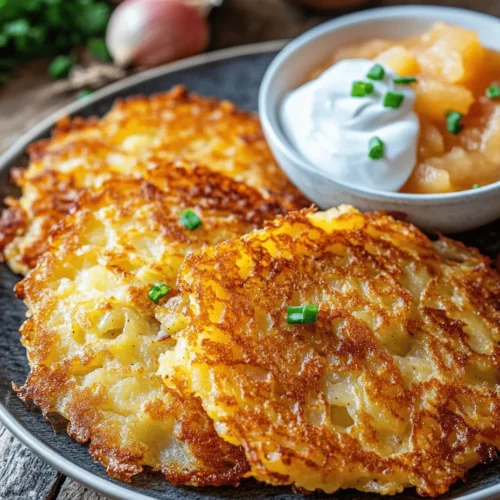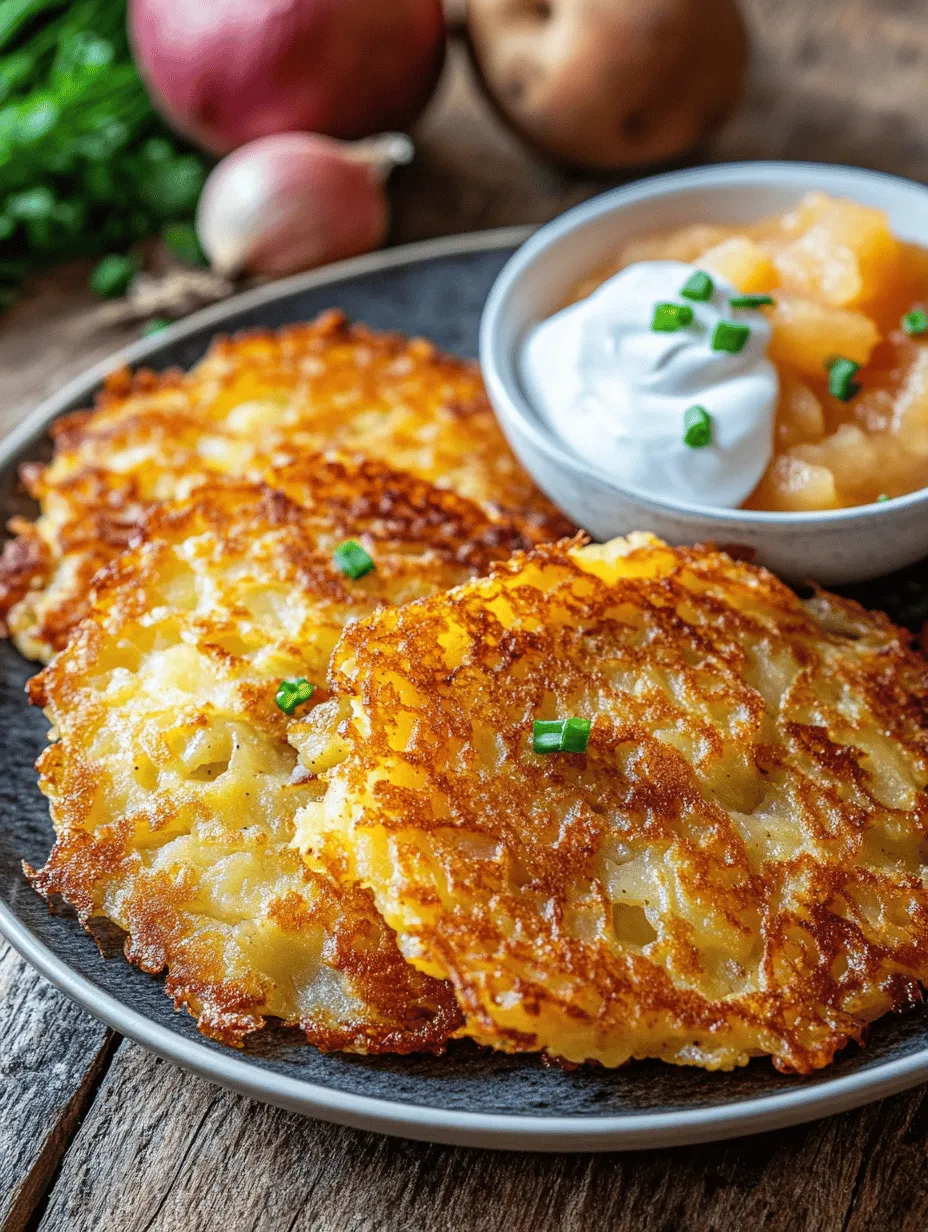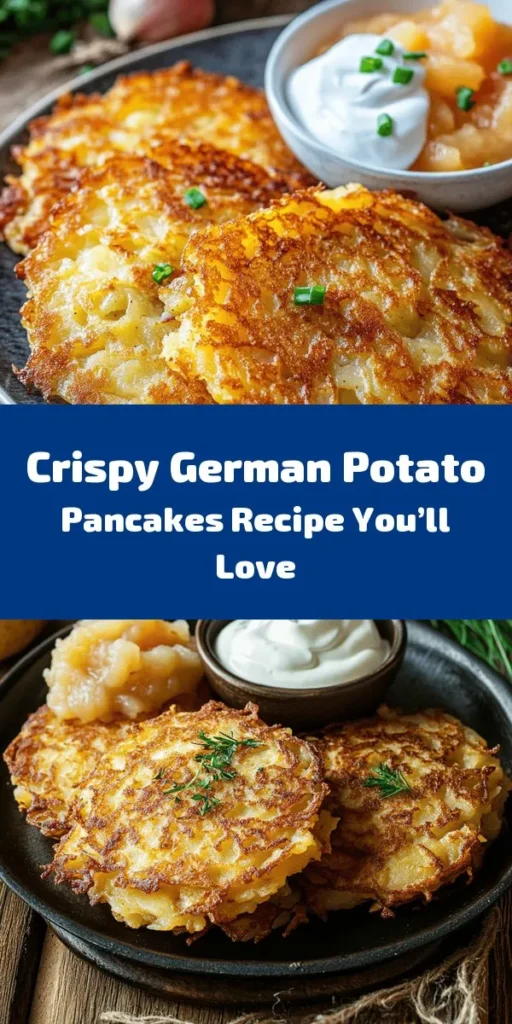Introduction
German potato pancakes, known as “Reibekuchen” or “Kartoffelpuffer,” are a cherished dish that has graced tables in Germany for centuries. These delectable treats are not just a staple in German cuisine; they embody the spirit of comfort food, bringing warmth and togetherness to family gatherings and festive occasions. Potato pancakes are typically crispy on the outside and tender on the inside, making them an irresistible addition to any meal. With their rich history, they have become a beloved dish not only in Germany but also among food enthusiasts around the world.
The quest for the perfect potato pancake lies in achieving that quintessential crispy texture that elevates the dish from ordinary to extraordinary. Each bite should deliver a satisfying crunch, paired with the soft, flavorful potato interior. This recipe aims to guide you through the simple yet effective steps to create these delightful pancakes, ensuring that you can replicate the authentic taste of Germany in your own kitchen.
In this recipe, you can expect an easy-to-follow approach that emphasizes traditional techniques while providing tips to enhance your cooking experience. Whether you are preparing these for a family dinner or a festive celebration, you will find that making crispy authentic German potato pancakes is both rewarding and enjoyable.
Understanding the Ingredients
To create the ultimate crispy German potato pancakes, it’s crucial to understand the key ingredients that contribute to their flavor and texture. Each component plays a vital role in crafting this iconic dish:
Russet Potatoes
The choice of potato is fundamental to the success of your potato pancakes. Russet potatoes are the preferred variety for this recipe due to their high starch content and low moisture levels. These attributes result in a fluffy interior and a crispy exterior when fried. Their earthy flavor provides a perfect base for the pancake, allowing the other ingredients to shine. When selecting your potatoes, look for firm, unblemished russets to ensure the best texture and taste.
Onion
Onion is another essential ingredient that adds depth and a hint of sweetness to the pancakes. It helps enhance the overall flavor profile and contributes moisture to the mixture. Finely grated onion infuses the pancakes with a subtle aroma, complementing the potatoes beautifully. While some variations of potato pancakes may omit onion, including it in your recipe will elevate the taste and authenticity of your dish.
Eggs and Flour
Eggs and flour serve as binding agents that lend structure to the pancakes. Eggs help to hold the grated potatoes together and provide richness, while flour ensures that the mixture has the right consistency for frying. The combination of these two ingredients creates a balanced texture, preventing the pancakes from falling apart during cooking. The amount of flour used can be adjusted based on the moisture content of your potatoes to achieve the desired consistency.
Baking Powder
While not always included in every potato pancake recipe, baking powder is a secret ingredient that contributes to a lighter texture. A small amount of baking powder can help create air pockets within the pancakes, resulting in a more delicate bite. This addition is especially important for those looking to achieve a fluffy interior while maintaining a crispy exterior.
Seasonings (Salt and Pepper)
Seasonings are fundamental in enhancing the overall taste of your potato pancakes. A generous pinch of salt elevates the natural flavors of the potatoes and onion, while freshly ground black pepper adds a touch of warmth and spice. Adjust the seasoning to your preference, but be mindful not to overpower the dish, as the beauty of potato pancakes lies in their simplicity.
Serving Suggestions
In Germany, potato pancakes are often served with applesauce or sour cream. The sweetness of applesauce provides a delightful contrast to the savory pancakes, while sour cream adds a creamy richness that complements their crispy texture. These traditional accompaniments not only enhance the flavor but also reflect the culture of German cuisine, which celebrates the harmony of flavors and textures.
Preparation Steps Unveiled
Now that you understand the ingredients, it’s time to delve into the preparation steps that will lead you to create the crispiest authentic German potato pancakes.
Preparing the Potatoes
The first step in making potato pancakes is preparing the potatoes. This process is crucial for achieving that desired crispiness. Begin by peeling the russet potatoes, then rinse them under cold water to remove any dirt. Once clean, you will need to grate the potatoes.
Grating can be done using a box grater or a food processor. Both methods will yield excellent results, but using a food processor can save you time and effort. For a more traditional approach, a box grater allows you to have greater control over the size of the potato shreds. Regardless of the method, aim for fine to medium shreds, as this will maximize the surface area and promote even cooking.
After grating, the next crucial step is to remove excess moisture from the potatoes. Moisture is the enemy of crispiness, so it’s essential to wring out as much liquid as possible. Place the grated potatoes in a clean kitchen towel or cheesecloth, gather the corners, and twist to squeeze out the moisture. This technique not only enhances the crispiness but also ensures that your pancakes hold their shape during frying.
Mixing the Ingredients
Once you’ve prepared the potatoes and removed excess moisture, it’s time to mix all the ingredients together. In a large mixing bowl, combine the grated potatoes and finely grated onion. The onion should be incorporated evenly to ensure that every bite is infused with its flavor.
Next, add the eggs and flour to the potato and onion mixture. Begin by breaking the eggs into the bowl and gently whisking them to combine. This will help to evenly distribute the eggs throughout the mixture. Gradually add the flour, incorporating it into the potato mixture until fully combined. Be careful not to overmix, as this can lead to dense pancakes. The goal is to achieve a homogeneous mixture where the ingredients are well-distributed but still maintain some texture.
Finally, sprinkle in the baking powder, salt, and pepper. Gently fold these ingredients into the mix, ensuring they are evenly distributed. The mixture should be cohesive enough to hold together when formed into patties but still loose enough to create that light and airy texture you desire.
With all ingredients combined, you are now ready to form and cook your potato pancakes to perfection. The next steps will guide you through frying and achieving that perfect golden-brown crust that characterizes authentic German potato pancakes.

Frying Techniques
Frying potato pancakes to perfection requires attention to detail and an understanding of the right techniques. Here are some best practices to help you achieve crispy, golden-brown potato pancakes:
Best Practices for Skillet Preparation
Before you begin frying, ensure that your skillet is properly prepared. A heavy-bottomed skillet or cast-iron pan is ideal for even heat distribution. Start by placing the skillet on medium heat and allowing it to warm up for a few minutes. To ensure the skillet is ready for frying, add a small drop of water. If it sizzles and evaporates almost immediately, the pan is hot enough.
Importance of Oil Temperature in Frying
Oil temperature plays a crucial role in achieving crispy potato pancakes. For frying, use a high smoke point oil like canola, sunflower, or vegetable oil. The oil should be heated to around 350°F (175°C) before adding the potato mixture. If the oil is not hot enough, the pancakes will absorb excess oil and become soggy. Conversely, if the oil is too hot, the pancakes may brown too quickly on the outside while remaining undercooked on the inside. Use a kitchen thermometer to monitor the oil temperature, or carefully test it by adding a small spoonful of the potato mixture; it should sizzle upon contact.
Tips for Frying Batches Without Overcrowding the Pan
When frying potato pancakes, it’s essential to work in small batches to avoid overcrowding the pan. Overcrowding reduces the oil temperature, leading to soggy pancakes. Fry 3 to 4 pancakes at a time, allowing enough space for the oil to circulate. This will ensure even cooking and a crisp texture. If you need to make a large batch, keep the finished pancakes warm in a low oven (around 200°F or 93°C) while you fry the remaining batches.
Achieving the Perfect Golden Brown Color
The visual appeal of potato pancakes is largely defined by their golden brown color. To monitor frying time, cook the pancakes for about 3 to 4 minutes on one side, or until they develop a rich golden hue. Carefully flip them using a spatula and cook for an additional 3 to 4 minutes on the other side. Adjust the heat as necessary; if the pancakes are browning too quickly, lower the heat slightly. Conversely, if they are cooking too slowly, increase the heat. Remember, patience is key, as rushing the process can lead to uneven cooking.
Serving Suggestions and Pairings
Authentic German potato pancakes, or “Reibekuchen,” are traditionally served with a variety of accompaniments that enhance their flavor profile.
Traditional Serving Methods of Potato Pancakes in Germany
In Germany, potato pancakes are often served hot and fresh off the skillet, typically accompanied by applesauce or sour cream. The creaminess of the sour cream complements the crispy texture of the pancakes, while the sweetness of the applesauce provides a delightful contrast.
The Role of Applesauce and Sour Cream in Balancing Flavors
Applesauce and sour cream are not just traditional garnishes; they play a significant role in balancing the flavors of potato pancakes. The tanginess of sour cream cuts through the richness of the fried potatoes, while applesauce adds a sweet note that enhances the dish’s overall enjoyment. For a more adventurous twist, consider adding a sprinkle of cinnamon to the applesauce for added depth.
Variations in Toppings or Sides That Can Enhance the Dish
While applesauce and sour cream are classic toppings, you can experiment with various other accompaniments. Consider serving your potato pancakes with:
– Chives or Green Onions: Finely chopped green onions or fresh chives sprinkled on top can add freshness and a mild onion flavor.
– Smoked Salmon: For a luxurious twist, top your pancakes with slices of smoked salmon and a dollop of crème fraîche for a sophisticated brunch option.
– Sautéed Mushrooms: Earthy sautéed mushrooms add depth to the flavor profile and create a hearty meal.
– Herbed Yogurt Sauce: Mix plain yogurt with fresh herbs like dill, parsley, or chives for a refreshing sauce.
Nutritional Information
Understanding the nutritional profile of potato pancakes is essential for those mindful of their diet while still wanting to enjoy this delicious dish.
Overview of the Nutritional Profile of Potato Pancakes
A serving of homemade potato pancakes (approximately 4 pancakes) typically contains:
– Calories: 200-250
– Carbohydrates: 35-40 grams
– Protein: 3-5 grams
– Fat: 8-12 grams (depending on the amount of oil used)
– Fiber: 3-4 grams
Potato pancakes provide a good source of carbohydrates, making them a satisfying breakfast or brunch option. Additionally, they are relatively low in calories compared to other breakfast staples like pancakes or waffles.
Comparison with Other Common Breakfast Foods
When compared to traditional breakfast items like pancakes or French toast, potato pancakes are often a healthier choice. For instance, a standard serving of buttermilk pancakes can contain upwards of 350 calories, not including toppings. Moreover, potato pancakes are naturally gluten-free (when made with gluten-free flour) and can be a delightful alternative for those with dietary restrictions.
Cultural Context and History
Potato pancakes have a rich history in German cuisine, deeply rooted in tradition and culture.
Brief History of Potato Pancakes in German Cuisine
Potato pancakes emerged in Germany as a way to utilize leftover potatoes, especially during the winter months when fresh produce was scarce. These pancakes were initially a peasant dish, offering a hearty and filling option for families. Over time, they became a beloved staple in German households, celebrated for their simplicity and versatility.
Variations of the Dish Across Different Regions in Germany and Their Unique Spins
Across Germany, variations of potato pancakes can be found. In the Rhineland, they are often made with a touch of onion for added flavor, while in the north, they may include grated carrots for sweetness. Each region adds its unique twist, showcasing the versatility of this dish. In some areas, potato pancakes are served as a side dish alongside savory meat dishes, while in others, they are enjoyed solely as a snack.
Significance of Potato Pancakes in German Festivals and Family Gatherings
In Germany, potato pancakes hold a special place in cultural celebrations and family gatherings. They are often featured at Christmas markets, where vendors sell freshly fried pancakes to warm both hands and hearts. Family gatherings frequently include potato pancakes as a cherished tradition, bringing loved ones together to enjoy delicious food and shared memories.
Conclusion
In summary, making authentic German potato pancakes is a delightful culinary adventure that combines simple ingredients with deep cultural roots. The process of frying them to a crispy golden brown, paired with traditional toppings like applesauce and sour cream, creates a dish that is not only satisfying but also steeped in history.
As you try your hand at this recipe, you’re not just cooking a meal; you’re experiencing a taste of German tradition. Whether you serve them at breakfast, brunch, or as a savory snack, potato pancakes will undoubtedly impress your family and friends. So gather your ingredients, fire up the skillet, and enjoy the crispy goodness of homemade potato pancakes. With each bite, you’ll savor the flavors of Germany, right in your own kitchen.



